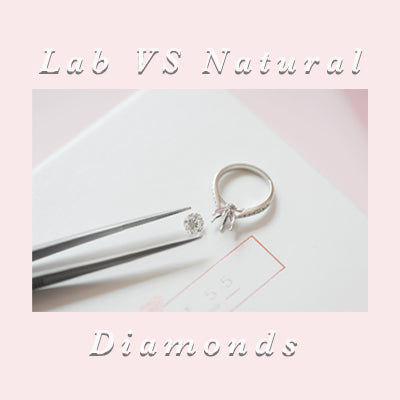Greetings
In the past few years, you might have heard of a new trend in the diamond world — lab grown diamonds. These synthetic diamonds are believed to be more ethically sourced and environmentally friendly than natural diamonds, because they aren’t scandaled with the ethical risks associated with blood diamonds and the accountability of environmental devastation. Today, we’ll address these stereotypes and compare lab-grown against natural diamonds.

Source: Carat 55
Similarities
Before we compare the differences between synthetic and natural diamonds, let's look at their similarities.According to the GIA, Gemological Institute of America, lab-grown diamonds “possess essentially the same chemical, physical and optical properties as its natural counterpart.” This just means that both types of diamonds are practically indiscernible from one another. Without the proper equipment and expertise, you’ll probably not be able to tell them apart. Even some professional gemologists have a hard time telling them apart.

Source: Carat 55
Main Differences
Now that you know about the similarities between lab-grown and natural diamonds, what about their differences? Their main differences can be broken down into, how they’re created, environmental & ethical impact, price & long term value.
The Process: How are diamonds formed?

Firstly, the main difference between synthetic diamonds and mined diamonds is the process of how they are formed. At 100 miles deep in the earth, natural diamonds are formed when extreme heat and pressure are applied onto graphite (a version of carbon). (Chemistry lesson alert!) The carbon in graphite’s atomic structure is altered, when each carbon atom is bonded to 3 other carbon atoms to produce the giant covalent structure of diamond. To put it simply, for synthetic diamonds, this process is just replicated in a lab, with man-made machines reproducing the extreme conditions required for diamonds to form.

Source: Carat 55
Ethical Impact
Another common concern when buying mined diamonds is the risk of supporting blood diamond trading. This is why the Kimberley Process Certification Scheme (KPSC) was created by the United Nations to ascertain the origins of diamonds in circulation. The practice of conflict diamonds is still ongoing in countries like Zimbabwe and Venezuela. However, to protect yourself from any unwanted ethical breaches, look for the GIA certified diamonds while purchasing your gem. This is because the GIA (Gemological Institute of America) is one of the most reliable labs in the industry.
Price & Resale Value
Generally, synthetic diamonds cost less than natural diamonds. It’s about a 30-50% price difference. This is because the creation of natural diamonds are dependent on mother nature. This means they are more rare and take a longer time to form. In comparison, lab-grown diamonds are much more readily available and take a shorter duration to create.
Since lab-grown diamonds are still so new, its long term value still remains unknown; unlike natural diamonds which generally have a predictable long term value. This also means that the resale value of lab grown diamonds might cause anxiety while natural diamonds are guaranteed to be sold for at least half of its original price (or potentially more).
Lab Grown or Natural? Up to you!
So, before I leave you, ask yourself why you want to purchase a diamond and what this diamond is going to mean to you (and your possible significant other?). Because there’s no conclusive moral argument or a right answer when it comes to comparing synthetic and mined diamonds.
Need Help?
Was this helpful? If not, book an appointment or head on down to Carat 55 to have a chat with our friendly team. You can DM us on Instagram, message us on Facebook, WhatsApp us or drop us an email too.


